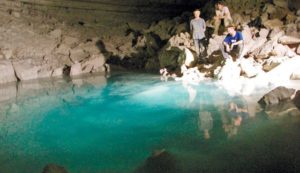Aliens in the Holyland
I’ve been pursuing this story for a couple of months. In the middle of it all, the following story broke in Israel.
A cave which has a pristine ecosystem – millions of years old – was found on the grounds of a cement factory. There is 100% humidity in the cave. There is a small pond in the cave system that is being fed by deep water springs from the deepest part of the earth. In this pool, they discovered 8 new species of life!
 The pool has been cut off from our atmosphere for approximately 260 million years i.e., before the continents separated! These life forms do not feed on photosynthesis, like you and me. Rather, they feed on chemosynthesis, much like life forms near hydrothermal vents (explored by James Cameron in “Aliens of the Deep”). The cave has been sealed for 6 years since it was found. It’s only now that the species have been scientifically defined.
The pool has been cut off from our atmosphere for approximately 260 million years i.e., before the continents separated! These life forms do not feed on photosynthesis, like you and me. Rather, they feed on chemosynthesis, much like life forms near hydrothermal vents (explored by James Cameron in “Aliens of the Deep”). The cave has been sealed for 6 years since it was found. It’s only now that the species have been scientifically defined.
I’m on this story, stay tuned…
excerpts from article in Haaretz.com
Underground, beneath the surface of the Nesher quarry in Ramle, lies a cave with a vast array of calcite burrows, almost three kilometers long. For millions of years, the only sound interrupting the silence was the gentle scurrying of small, blind, colorless creatures, completely unaware of the world above them.
Before the quarry became active, the cave and tunnels were situated about 100 meters under ground level. In 2005, the first rays of light invaded the burrows, when a quarry bulldozer happened upon them. Scientists arriving at the scene, to research what they swiftly termed the “Ayalon Cave,” discovered a unique form of life existing nowhere else on the planet: eight unknown species of crab, other arthropods and an eyeless scorpion.
The scientists shipped the creatures to labs throughout the world and now, six years on, the first part of the research is over, after most species were identified and described.
The scientists discovered an independent ecosystem in the underground cave that isn’t based on photosynthesis. Since there was no light in the cave, or other known biological processes, the organisms in the cave were dependent on a process known as chimeotothropia which exists in other areas on earth, such as the bottom of the ocean.
The most important factors in the ecosystem are sulphur bacteria that, lacking light, evolve through a different chemical process. “All the nutrition systems within the cave are based upon these bacteria,” says Hanan Dimentman from the Hebrew University of Jerusalem, who led the biological research in the cave. “There are creatures that eat the bacteria, those who devour the bacteria eaters, and there’s the carnivores.”
Due to their isolation, the creatures evolved into unique species which exist nowhere else on the planet. In fact, they are evolutionary remains of life that became extinct millions of years ago. The largest earth species discovered was the Israchanani scorpion, named after the two researchers of the cave, Yisrael Naaman and Hanan Dimentman.
The largest water creature found there evolved from a crab that roamed the Mediterranean Sea several million years ago. The water species thrive in a small pool in the cave’s largest hall, 40 meters high. The pool consists of salty groundwater containing sulphur.
for the full article click here.

